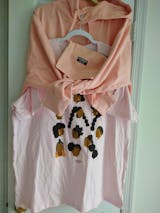How To Wash Natural Hair (And How Often)

Much like many other natural hair tips and advice, how to wash natural hair isn’t one-size-fits-all. That means there isn’t a singular answer when someone asks, “How often should you wash your hair?” In all honesty, the frequency of your wash days depends on your shampoo, personal preference, and the state of your natural hair. With that said, there’s a strong chance that you should be cleansing more often than you have been—or at least think you should be.
It’s very common and understandable to have hesitancy about overwashing natural hair. It’s the driest of the bunch, which makes it a lot more prone to damage, breakage, and curl pattern changes. However, there’s one big takeaway that those with natural hair need to remember: Water is your friend. It’s all about balance, and with the right hair care products and hair washing routine, you can absolutely make the most of each wash day. Here’s what you need to know.

How Often Should You Wash Natural Hair?
Although there isn’t an exact science to figuring out how often you should wash your hair, since it depends on a few factors. To determine how often you should wash your hair, consider how much product and the types of products you’re using on a regular basis.
Wash your hair once a week if … your hair requires heavier oils, gels that might flake after a few days, or hairsprays that leave hair stiff. This also may be what’s needed if you have an oily scalp. Piling product on top of the natural oils that your scalp produces, particularly if it’s in excess, can not only clog the hair follicle but also might lead to irritation, inflammation, itching, and in more severe cases, follicle damage or hair loss.
Wash your hair twice a month if … you add heat to style your hair with a diffuser to dry, a curling wand to define, or even if you blow dry your hair straight on a regular basis. When you add heat to style your hair, cutting the wash frequency back to every other week can be beneficial. Even if you’re using a heat protectant (which you absolutely should be), there may be some level of moisture stripping happening. When you do shampoo, use a moisture-boosting shampoo to help bring back any lost hydration.
Wash your hair once a month if … your hair is drier or if your scalp is more on the normal to dry side. Once a month shampooing will likely be an ideal step for you. Of course, you can always adjust if in between washes you’re feeling itchy or if you work out often and sweat a lot. Otherwise, weekly shampoos may better suit your active lifestyle to keep hair feeling and smelling fresh.

Should You Shampoo Natural Hair?
Contrary to popular opinion, natural hair needs shampoo. A lot of naturals are die-hard co-wash fans, and this is totally fine. However, a traditional shampoo is highly needed to help remove excess oil and product buildup, something a cleansing conditioner isn’t designed to do.
What Should You Use To Wash Natural Hair?
No matter your hair type, curl pattern, or the current state of your hair, what’s most important is the type of hair shampoo you use. Sulfate-free shampoo is key as it will give your hair and scalp the necessary cleansing to keep it strong and growing, without stripping any natural oils.
How Should You Wash Your Hair?
This may seem unnecessary, but there’s actually a method to washing, especially if you’re shampooing natural hair. This will ensure that you keep your hair from getting damaged and help eliminate frizz when you get to styling. Here are our hair washing tips.
Step 1: Check your water temps. Much like skin, hot water can dry hair out. Yes, we know it feels luxurious to run hot water through your hair, but the heat can strip your hair of essential oils. Wash with lukewarm or room temperature water instead, and finish with a cool rinse.
Step 2: Portion out the shampoo. Have you ever wondered, “How much shampoo should I use for my hair?” Well, let me tell you: You shouldn’t just squeeze a sizeable amount of product onto your locks and hope for the best. Pour shampoo into the palm of your hands and not directly onto hair. This will ensure that you’re doling out the right amount and not overdoing it.
It’s better to start with a smaller amount of product (about a golf-ball-size) through your hair and add more if needed, rather than to douse your head with it. It’s unnecessary. Shampoo should primarily be applied on your scalp and not the length of your hair (more on that in a minute), if you’re used to coating every inch of your strands, you may be accustomed to washing with way too much of your favorite hair shampoo.
Want to know what’s also unnecessary? That whole lather, rinse, repeat deal. We’ve already gone over that you likely don’t need to wash your hair more than once a week—you definitely don’t need to lather up multiple times during the same shower.
Step 3: Work through your scalp. Start by massaging the shampoo into your roots. You want most of the product to be concentrated on the scalp as that’s where the majority of buildup, dirt, and oil usually sits. Work the product around the scalp in a back and forth motion. Not in circles! This will tangle your hair and make it more difficult to comb through later.
Step 4: Cleanse and finger comb the hair. Use your fingers only and not any brushes or combs to gently work the shampoo through the length of your hair. Try to gently detangle a little bit as you go. You want to start the detangling process while you have product in your hair, so that even if it’s not all the way knot-free before rinsing, you can at least run your fingers through larger sections.
Step 5. Massage as you rinse. Once you’ve worked the shampoo through to the ends, it’s time to rinse. How you do this is equally as important as how you applied and worked it through. Rub your hands all the way from root to tip as water flows through your hair. This will ensure that all of the shampoo gets out, and your hair is ready for your conditioner. You don’t want any shampoo residue to get in between your strands and the conditioner or detangling cream you’ll be applying next.
Step 6. Follow with conditioner. You knew this was coming. Cleansing and conditioning go together just as perfectly as any dynamic duo ever has. After washing out all of your shampoo, apply your conditioner. It’s best to stick with a conditioner that coordinates with your shampoo—aka one that’s part of the same hair care system—instead of mixing and matching. Apply the formula to your hair, focusing it on the mid-lengths to ends rather than your roots. Let your conditioner sit for the designated amount of time—probably between two and five minutes—then rinse it out with cool water.
Step 7. Use a leave-in. Squeeze any excess water out of your hair to prep it for a leave-in conditioner. Pick one based on what your hair needs. Does your hair need a boost of definition? Is it dying for more moisture? Are you trying to fight off frizz before your hair dries? Choose wisely!
Step 8. Dry your hair. Don’t want to leave your hair sopping wet? We get it. To soak up a little bit of the water, use a soft cotton T-shirt to gently dry your hair. This will be more gentle than a terry cloth towel. If you’re in a rush, you can break out your blow-dryer, but make sure to use heat protectant, and we’d recommend reading up on our previous blog “Air Drying vs Diffusing”, first.

When Should You Wash Natural Hair?
Aside from the frequency, it’s also important to note the best time of day to wash your hair. Of course, this tip is merely a suggestion, but it could impact the long term health of your hair. Hair is most fragile when wet, so you typically want to avoid sleeping on wet hair. Knowing that, you should give hair enough time to air dry—before you go to bed—if you prefer to style it without heat. Even with a protective bonnet or satin pillowcase, any bit of friction against damp or wet hair may lead to breakage and frizz. For this reason, many people with natural hair prefer to wash their hair in the morning to give it plenty of dry time.
You should also take note of your hair’s porosity. This will determine things like how long it takes your hair to dry and even plays a part in how your hair absorbs and retains moisture when you wash it. With that, check out our “What’s Your Hair Porosity?” blog!
How Often Should You Condition Natural Hair?
Once you know the answer to how often you should cleanse natural hair, it only fits that you ask how frequently your hair should be conditioned. And believe it or not, there is such a thing as over conditioning your hair. Of course, soft, moisturized strands are the goal, but using too much conditioner, deep treating it too often, or leaving a conditioner on for longer than the recommended time frame can leave hair limp and fragile. Determining when to lay off with conditioning shouldn’t be too hard. You’ll be able to tell pretty easily if your waves, curls or coils look lifeless or if you’re having a hard time getting your hair to hold a style. If this happens, you’ll need a product with Protein in it to help Balance your Moisture level.
To get your hair on a better conditioning routine, try using a conditioner on a weekly basis. Weekly treatments with a natural hair conditioner are ideal for all curl types. If your hair is drier, you can amp by adding hair masks or a deep conditioner on a bi-weekly basis. For finer hair or strands that are not typically super dry, you can cut back to using the deep treatments once a month, but stick with the regular conditionings with a light leave-in formula.
Take note of how you condition as well. We touched on this a little, but the point of the conditioner is to replenish moisture, rebalance, and help seal in water from washing your hair. There’s no need to apply conditioner to your scalp, even if it tends to be dry. There are other products such as Donna’s Strength Hair Oil that you can use at the styling phase to help soothe a dry scalp. Even super coily and dry strands don’t need conditioner at the roots, instead, apply it from the mid-shaft down to the ends of hair. Remember, natural hair especially needs the most moisture at the tips, so focus the application there.

Share how you cleanse and condition your hair on social media using the hashtag #DonnasRecipe! Feel free to follow and tag us on @DonnasRecipe to be featured!



















Leave a comment